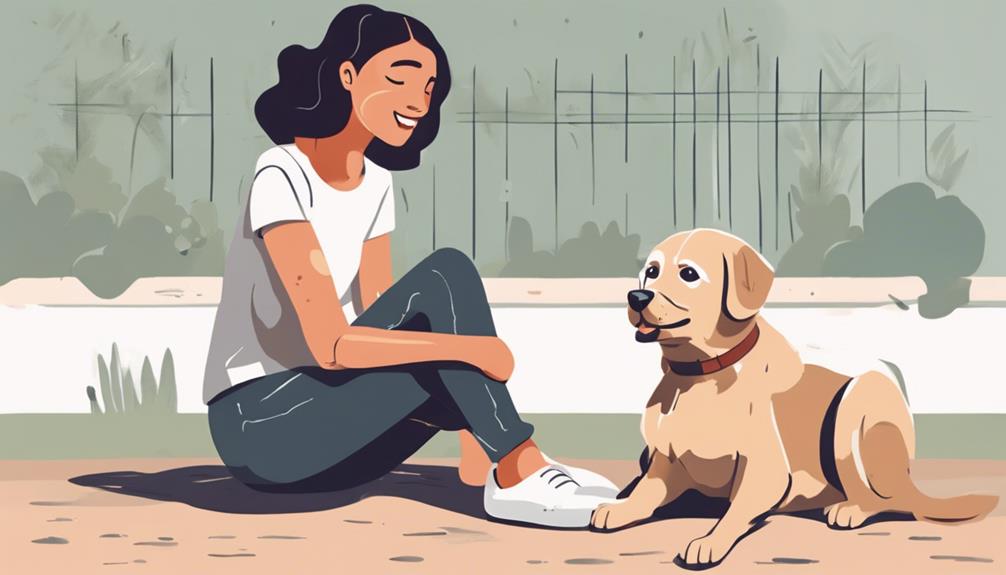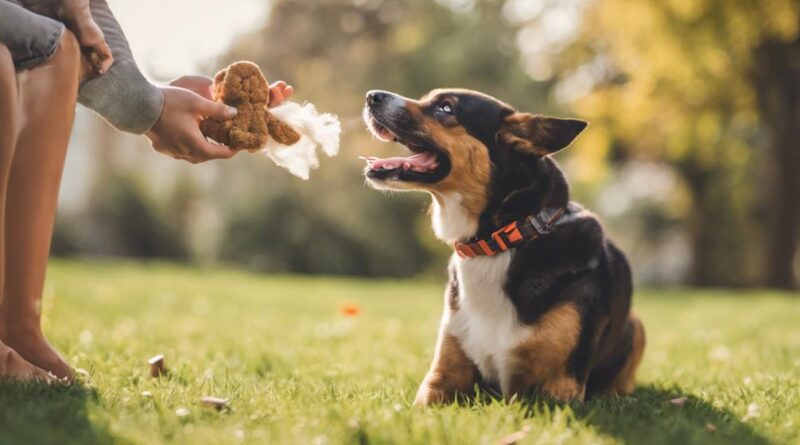Seven Effective Tips on Psychology-Based Dog Training
In the world of dog training, the line between behavior and psychology is often blurred. By understanding the intricate ways in which your dog communicates, you can unlock a whole new level of training success.
But how exactly can this understanding improve your training sessions and deepen the bond with your furry companion? Let's explore seven effective tips that are grounded in psychology-based techniques to help you navigate the world of dog training with confidence and insight.
Understanding Canine Communication
To truly understand your dog's behavior, pay close attention to their body language and vocalizations. Canine body language is a crucial aspect of communication that dogs use to express their emotions and intentions. Watch for cues like tail wagging, ear position, and overall posture to gauge how your dog is feeling. For example, a tucked tail and flattened ears may indicate fear or anxiety, while a wagging tail held high signals excitement or confidence.
Vocal cues and signals also play a significant role in canine communication. Dogs use barks, growls, whines, and howls to convey different messages. A sharp, high-pitched bark may signal alertness or excitement, while a low, guttural growl can indicate aggression or discomfort. Pay attention to the pitch, intensity, and duration of your dog's vocalizations to better understand their needs and feelings.
Establishing Pack Leadership
Pay close attention to your behavior and interactions with your dog to establish clear pack leadership. Here are some key tips to help you effectively establish yourself as the leader of the pack:
- Consistent Rules: Establish and maintain consistent rules and boundaries for your dog. Dogs thrive on structure and clear expectations.
- Confident Body Language: Use confident body language to convey authority. Stand tall, make direct eye contact, and use a firm but gentle tone.
- Decision-Making: Practice making decisions for your dog, such as when to eat, go for a walk, or play. This reinforces your role as the leader.
- Reward Good Behavior: Acknowledge and reward good behavior to reinforce positive interactions and strengthen the bond between you and your dog.
Using Positive Reinforcement Techniques
When training your dog, utilizing positive reinforcement techniques is key to encouraging desired behaviors. Clicker training, a popular method, involves using a clicker to mark the exact moment your dog performs a desired behavior, followed by a treat reward. This technique helps your dog understand which behaviors earn rewards, making learning more efficient.
Shaping behavior is another effective strategy where you gradually shape complex behaviors by rewarding small steps towards the desired outcome. For instance, if you want your dog to roll over, you'd initially reward them for lying down, then for shifting their weight, and finally for completing the full roll-over motion.
To start clicker training, introduce the clicker as a signal for a treat reward. Click when your dog displays the desired behavior, then offer a treat immediately. Consistent practice using treat rewards and clicker training techniques will help reinforce positive behaviors effectively.
Addressing Behavioral Issues Promptly
Address behavioral issues promptly by identifying the root causes and implementing targeted training strategies to address them effectively. Behavior modification is crucial in shaping your dog's actions and reactions. Here are four essential steps to help you tackle behavioral issues head-on:
- Observe Closely: Pay close attention to your dog's behavior to pinpoint specific triggers or patterns causing the issue. This keen observation will provide valuable insights into the root cause.
- Consistent Training: Implement consistent training strategies tailored to address the identified behavioral issues. Consistency is key to helping your dog understand what's expected of them.
- Positive Reinforcement: Use positive reinforcement techniques to encourage desired behaviors. Rewarding good behavior helps reinforce positive actions and strengthens the bond between you and your dog.
- Seek Professional Help: If the behavioral issues persist or are complex, don't hesitate to seek guidance from a professional dog trainer or behaviorist. They can offer specialized training strategies to address the specific problems effectively. Remember, addressing behavioral issues promptly can lead to a happier and well-adjusted furry friend.
Incorporating Play and Exercise
To enhance your dog's overall well-being and behavior, engaging in play and exercise regularly is essential. Interactive games and physical activity are crucial components of a well-rounded training routine. Interactive games, such as hide-and-seek or puzzle toys, not only provide mental stimulation but also strengthen the bond between you and your furry friend. These games can help in reducing boredom and preventing destructive behaviors that may stem from lack of mental engagement.
Additionally, incorporating physical activity into your dog's daily routine is vital for their physical health and emotional well-being. Regular walks, runs, or play sessions in the backyard can help your dog release excess energy, reduce anxiety, and promote relaxation. Physical exercise is a great way to prevent obesity and maintain a healthy weight for your canine companion. By combining interactive games with physical activities, you aren't only training your dog but also ensuring their holistic development and happiness.
Maintaining Consistent Training Routines
Consistency in training routines is key to reinforcing desired behaviors in your dog and fostering a strong training foundation. By maintaining a consistent approach to training, you establish clear expectations for your furry friend and create a structured environment for learning.
Here are some essential tips to help you maintain consistent training routines:
- Set a Schedule: Establish a regular training schedule that fits into your daily routine. Consistency in timing will help your dog understand when to expect training sessions.
- Use Positive Reinforcement: Reward your dog consistently for good behavior to reinforce positive habits. This will motivate them to continue exhibiting the desired behaviors.
- Stay Patient and Persistent: Consistency requires patience and persistence. Stay dedicated to your training routines even if progress seems slow at times.
- Avoid Mixed Signals: Be clear and consistent in your commands and expectations. Mixed signals can confuse your dog and hinder their learning progress.
Building Trust and Bonding With Your Dog

When it comes to building trust and bonding with your dog, creating a strong foundation through consistent training routines is essential. By maintaining a predictable schedule and using positive reinforcement techniques, you can help your dog feel secure and develop trust in you as their leader. Building confidence in your dog involves providing praise and rewards for good behavior, which helps them feel appreciated and understood.
To strengthen your connection with your furry friend, engage in interactive play sessions and spend quality time together. This not only enhances the bond between you but also allows you to understand your dog's needs and preferences better. Additionally, incorporating training exercises into your daily routine can further solidify the trust and communication between you and your dog.
Seeking Professional Help When Needed
If you find yourself struggling to address behavioral issues or challenges with your dog, consider seeking professional help from a certified dog trainer or behaviorist. Here are some reasons why seeking professional help can be beneficial:
- Trainer Selection: A professional trainer can provide you with the expertise and guidance needed to address your dog's specific behavioral issues effectively.
- Consultation: A consultation with a professional can help you understand the root cause of your dog's behavior problems and create a tailored training plan.
- Behavioral Evaluation: A trained behaviorist can conduct a comprehensive evaluation of your dog's behavior to identify any underlying issues that may be contributing to the problem.
- Intervention: Professional intervention can help you implement the right techniques and strategies to modify your dog's behavior positively, leading to a happier and healthier relationship between you and your furry companion.
Frequently Asked Questions
How Can I Help My Dog Overcome Separation Anxiety?
To help your dog overcome separation anxiety, try gradual desensitization by leaving for short periods and gradually increasing the time away.
Provide interactive toys or treats to keep them occupied. Building confidence through positive reinforcement and socialization can also help.
Seek professional guidance if needed. Remember, consistency and patience are key when implementing coping strategies for separation anxiety in your furry friend.
What Are Some Strategies for Training a Shy or Fearful Dog?
To help your shy or fearful dog, focus on building confidence and trust. Start with socialization to help them become more comfortable around new people and environments.
Use desensitization techniques to gradually expose them to their fears in a controlled way. Positive reinforcement and patience are key in helping your dog overcome their shyness and fearfulness.
Consistent training and gentle encouragement will go a long way in boosting their self-assurance.
Can You Recommend Any Specific Games or Activities to Mentally Stimulate My Dog?
To mentally stimulate your dog, try using enrichment toys like treat dispensers or puzzle games. Interactive training sessions can engage your dog's mind while strengthening your bond.
Nose work activities, where your dog uses their sense of smell to find hidden treats or toys, are also great for mental stimulation. These games and activities will keep your dog entertained and mentally sharp.
What Should I Do if My Dog Shows Aggression Towards Other Dogs or People?
If your dog shows aggression towards other dogs or people, focus on aggression management and behavior modification. Use socialization techniques and desensitization methods to help your dog adjust positively to these situations.
Seek professional guidance if needed, and be patient during the process. Consistency and positive reinforcement are key in addressing and modifying this behavior.
How Can I Prevent My Dog From Developing Destructive Behaviors When Left Alone?
To prevent your dog from developing destructive behaviors when left alone, consider crate training and providing mental stimulation. Use positive reinforcement and desensitization techniques to create a calm environment.
Start by gradually increasing the time your dog spends alone. Offer engaging toys or puzzles to keep them occupied. Reward good behavior and ignore unwanted actions.
Consistency and patience will help your dog adjust and feel secure when alone.
Conclusion
In conclusion, by understanding your dog's communication, establishing pack leadership, using positive reinforcement, addressing behavioral issues promptly, incorporating play and exercise, maintaining consistent training routines, and building trust and bonding, you can effectively train your dog using psychology-based techniques.
Remember, seeking professional help when needed is also important for successful training. With patience, consistency, and love, you and your furry friend can enjoy a strong and harmonious relationship.
